软件定义网络实验七
实验7:基于REST API的SDN北向应用实践
基本实验
实验步骤1
- 利用Mininet平台搭建下图所示网络拓扑,并连接OpenDaylight;
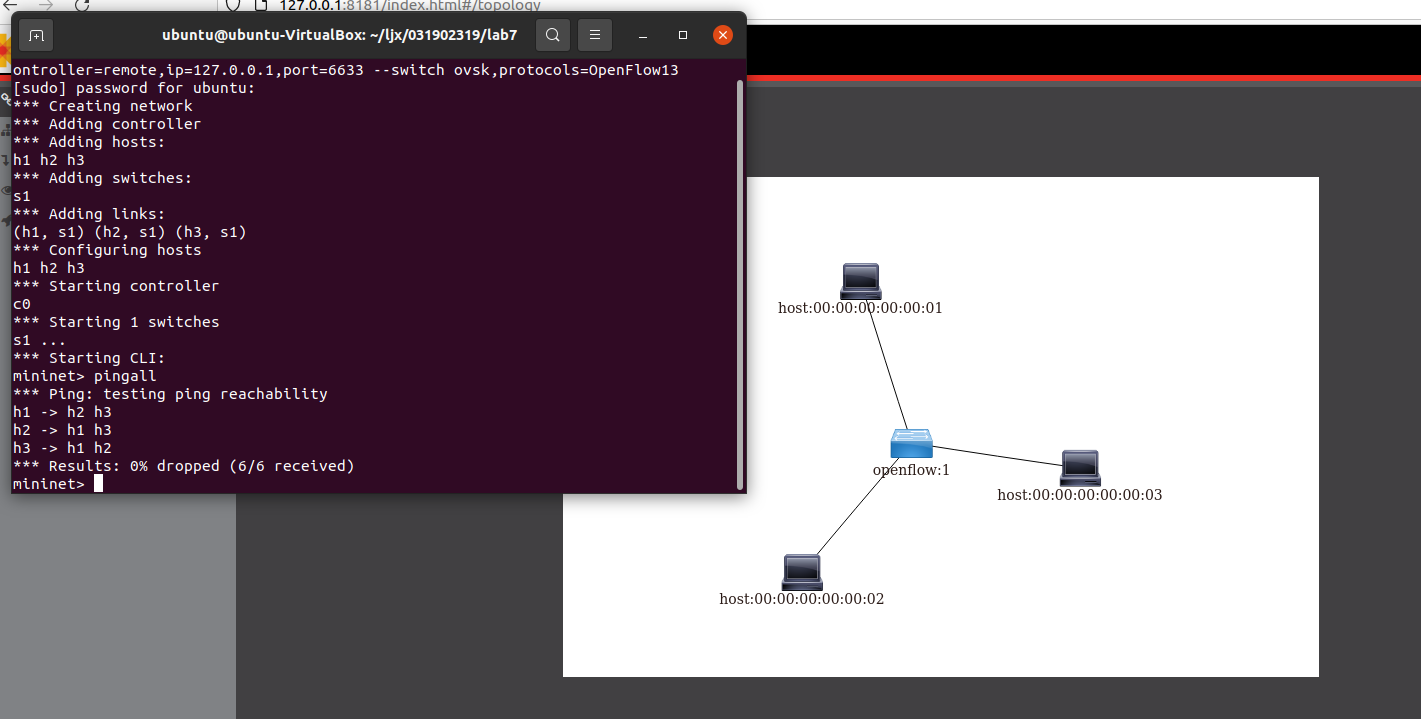
实验步骤2
编写Python程序,调用OpenDaylight的北向接口下发指令删除s1上的流表数据。
import requests
from requests.auth import HTTPBasicAuth
def http_delete(url):
url= url
headers = {'Content-Type':'application/json'}
resp = requests.delete(url,headers=headers,auth=HTTPBasicAuth('admin', 'admin'))
return resp
if __name__ == "__main__":
url='http://127.0.0.1:8181/restconf/config/opendaylight-inventory:nodes/node/openflow:1/'
resp = http_delete(url)
print (resp.content)
- 执行结果
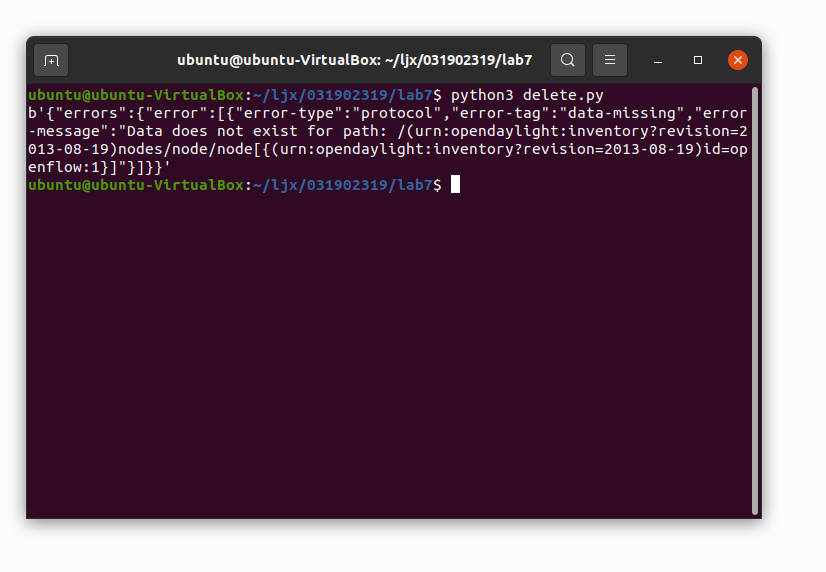
实验步骤3
- 编写Python程序,调用OpenDaylight的北向接口下发硬超时流表,实现拓扑内主机h1和h3网络中断20s。
编写代码并命名为puts.py以及ODL_flowtable.json文件
输入h1 ping h3 ,执行该程序
#puts.py
import requests
from requests.auth import HTTPBasicAuth
if __name__ == "__main__":
url = 'http://127.0.0.1:8181/restconf/config/opendaylight-inventory:nodes/node/openflow:1/flow-node-inventory:table/0/flow/1'
with open("./ODL_flowtable.json") as f:
jstr = f.read()
headers = {'Content-Type': 'application/json'}
res = requests.put(url, jstr, headers=headers, auth=HTTPBasicAuth('admin', 'admin'))
print (res.content)
ODL_flowtable.json
{
"flow": [
{
"id": "1",
"match": {
"in-port": "1",
"ethernet-match": {
"ethernet-type": {
"type": "0x0800"
}
},
"ipv4-destination": "10.0.0.3/32"
},
"instructions": {
"instruction": [
{
"order": "0",
"apply-actions": {
"action": [
{
"order": "0",
"drop-action": {}
}
]
}
}
]
},
"flow-name": "flow1",
"priority": "65535",
"hard-timeout": "20",
"cookie": "2",
"table_id": "0"
}
]
}
- 执行结果
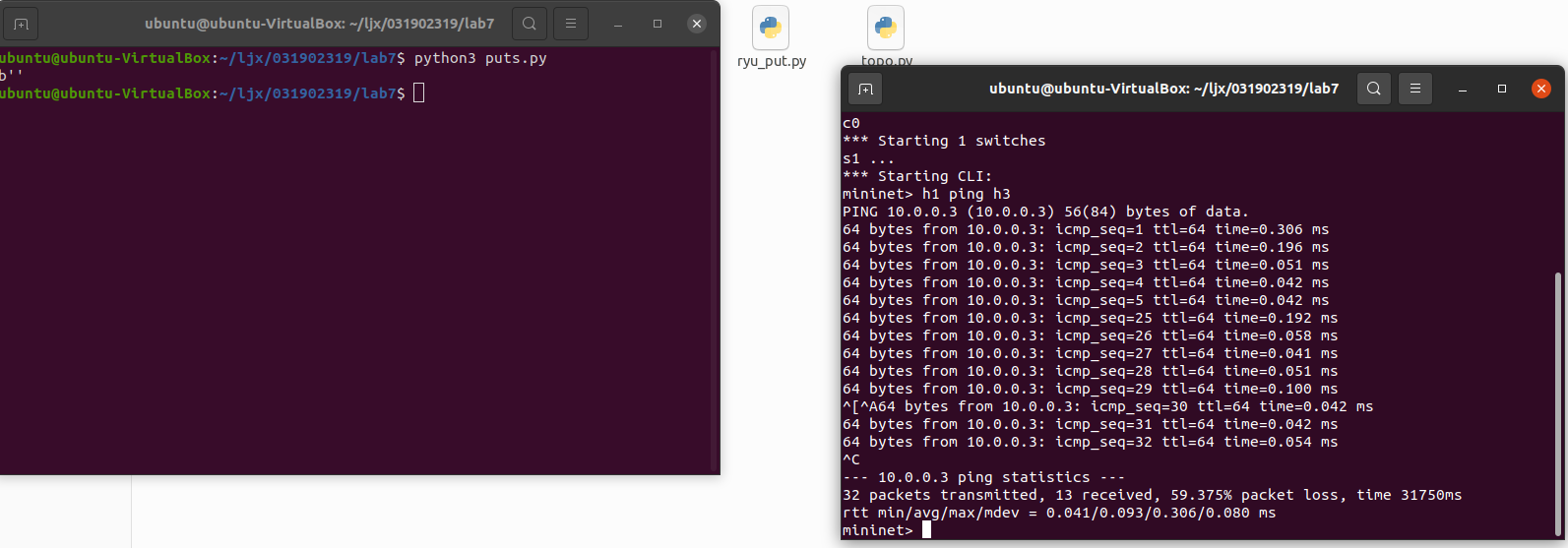
实验步骤4
- 编写Python程序,调用OpenDaylight的北向接口获取s1上活动的流表数。
编写代码并命名为get.py
在终端执行
#get.py
import requests
from requests.auth import HTTPBasicAuth
if __name__ == "__main__":
url = 'http://127.0.0.1:8181/restconf/operational/opendaylight-inventory:nodes/node/openflow:1/flow-node-inventory:table/0/opendaylight-flow-table-statistics:flow-table-statistics'
headers = {'Content-Type': 'application/json'}
res = requests.get(url,headers=headers, auth=HTTPBasicAuth('admin', 'admin'))
print (res.content)
- 执行结果

实验步骤5
- 编写Python程序,调用Ryu的北向接口,实现上述OpenDaylight实验拓扑上相同的硬超时流表下发。
编写代码并命名为ryu_put.py以及flowtable.json
#ryu_put.py
import requests
if __name__ == "__main__":
url = 'http://127.0.0.1:8080/stats/flowentry/add'
with open("./flowtable.json") as f:
jstr = f.read()
headers = {'Content-Type': 'application/json'}
res = requests.post(url, jstr, headers=headers)
print (res.content)
flowtable.json
{
"dpid": 1,
"cookie": 1,
"cookie_mask": 1,
"table_id": 0,
"hard_timeout": 20,
"priority": 65535,
"flags": 1,
"match":{
"in_port":1
},
"actions":[
]
}
- 执行结果
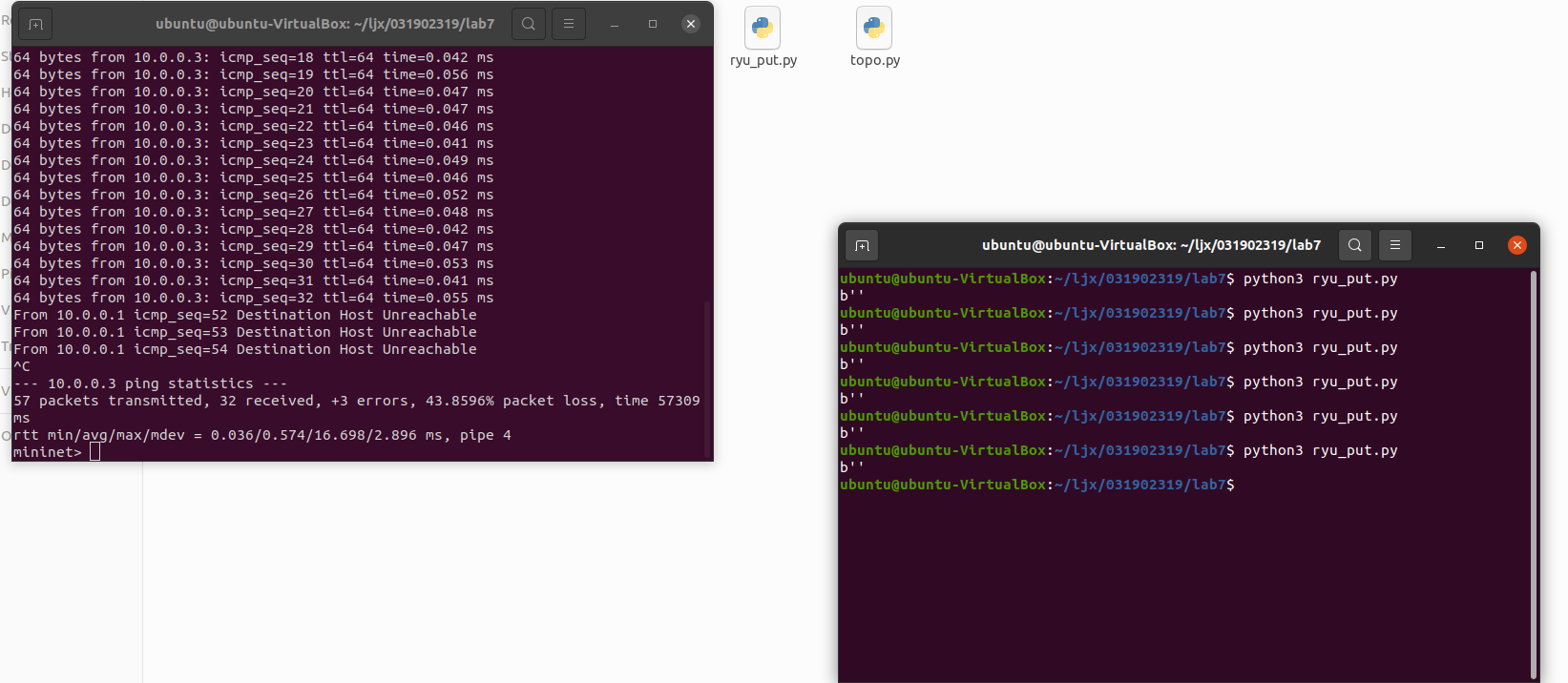
实验步骤6
- 利用Mininet平台搭建下图所示网络拓扑,要求支持OpenFlow 1.3协议,主机名、交换机名以及端口对应正确。拓扑生成后需连接Ryu,且Ryu应能够提供REST API服务。
编写以下代码
#topo.py
from mininet.topo import Topo
class MyTopo(Topo):
def __init__(self):
# initilaize topology
Topo.__init__(self)
self.addSwitch("s1")
self.addSwitch("s2")
self.addHost("h1")
self.addHost("h2")
self.addHost("h3")
self.addHost("h4")
self.addLink("s1", "h1")
self.addLink("s1", "h2")
self.addLink("s2", "h3")
self.addLink("s2", "h4")
self.addLink("s1", "s2")
topos = {'mytopo': (lambda: MyTopo())}
- 执行结果
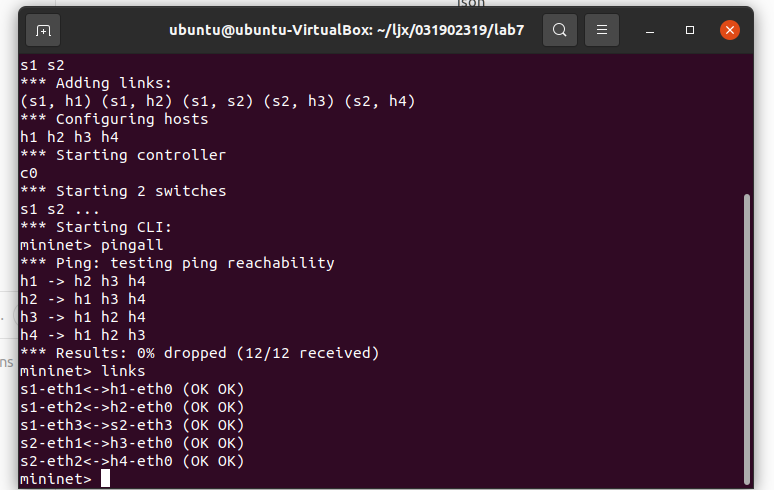
实验步骤7
- 整理一个Shell脚本,参考Ryu REST API的文档,利用curl命令,实现和实验2相同的VLAN。
# 将主机1,2发送来的数据包打上vlan标记
curl -X POST -d '{
"dpid": 1,
"priority": 1,
"match":{
"in_port": 1
},
"actions":[
{
"type": "PUSH_VLAN",
"ethertype": 33024
},
{
"type": "SET_FIELD",
"field": "vlan_vid",
"value": 4096
},
{
"type": "OUTPUT",
"port": 3
}
]
}' http://localhost:8080/stats/flowentry/add
curl -X POST -d '{
"dpid": 1,
"priority": 1,
"match":{
"in_port": 2
},
"actions":[
{
"type": "PUSH_VLAN",
"ethertype": 33024
},
{
"type": "SET_FIELD",
"field": "vlan_vid",
"value": 4097
},
{
"type": "OUTPUT",
"port": 3
}
]
}' http://localhost:8080/stats/flowentry/add
# 将主机3,4发送来的数据包取出vlan标记
curl -X POST -d '{
"dpid": 1,
"priority": 1,
"match":{
"vlan_vid": 0
},
"actions":[
{
"type": "POP_VLAN",
"ethertype": 33024
},
{
"type": "OUTPUT",
"port": 1
}
]
}' http://localhost:8080/stats/flowentry/add
curl -X POST -d '{
"dpid": 1,
"priority": 1,
"match":{
"vlan_vid": 1
},
"actions":[
{
"type": "POP_VLAN",
"ethertype": 33024
},
{
"type": "OUTPUT",
"port": 2
}
]
}' http://localhost:8080/stats/flowentry/add
# 将主机3,4发送来的数据包打上vlan标记
curl -X POST -d '{
"dpid": 2,
"priority": 1,
"match":{
"in_port": 1
},
"actions":[
{
"type": "PUSH_VLAN",
"ethertype": 33024
},
{
"type": "SET_FIELD",
"field": "vlan_vid",
"value": 4096
},
{
"type": "OUTPUT",
"port": 3
}
]
}' http://localhost:8080/stats/flowentry/add
curl -X POST -d '{
"dpid": 2,
"priority": 1,
"match":{
"in_port": 2
},
"actions":[
{
"type": "PUSH_VLAN",
"ethertype": 33024
},
{
"type": "SET_FIELD",
"field": "vlan_vid",
"value": 4097
},
{
"type": "OUTPUT",
"port": 3
}
]
}' http://localhost:8080/stats/flowentry/add
curl -X POST -d '{
"dpid": 2,
"priority": 1,
"match":{
"vlan_vid": 0
},
"actions":[
{
"type": "POP_VLAN",
"ethertype": 33024
},
{
"type": "OUTPUT",
"port": 1
}
]
}' http://localhost:8080/stats/flowentry/add
curl -X POST -d '{
"dpid": 2,
"priority": 1,
"match":{
"vlan_vid": 1
},
"actions":[
{
"type": "POP_VLAN",
"ethertype": 33024
},
{
"type": "OUTPUT",
"port": 2
}
]
}' http://localhost:8080/stats/flowentry/add
运行程序
- 执行结果

个人总结
- 实验难度相较之前的所有实验难度都相较高
- 实验过程遇到的困难及解决办法
-
运行ryu,pingall测试各主机均不连通,类似于上一次的实验,在了同学的帮助和阅读了同学的博客写的困难,看到同样的问题和解决方案,问题得到解决
-
安装curl,在过程中提示需要安装curl,刚开始没能理解报错,弄了很久,后面发现报错提示安装curl,根据提示输入命令安装,问题解决
-
VLAN划分结果没能正确得到由于没有删除之前遗留的流表。
个人感想
- 通过本次实验,以自己编写的程序来调用ODL的北向接口实现部分功能,对基于REST API的SDN北向应用有了更加清晰的认识和理解,也对流表遗留所造成的问题有了了解,对于curl命令有了初步的学习与运用,虚拟机和终端的使用更加的熟悉。


 浙公网安备 33010602011771号
浙公网安备 33010602011771号